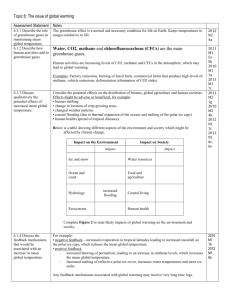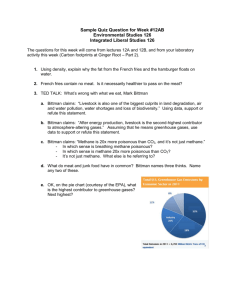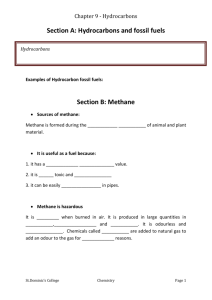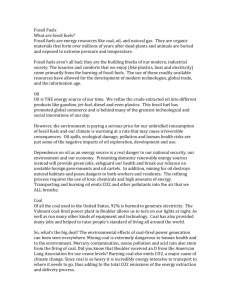Year 10 Revision
advertisement
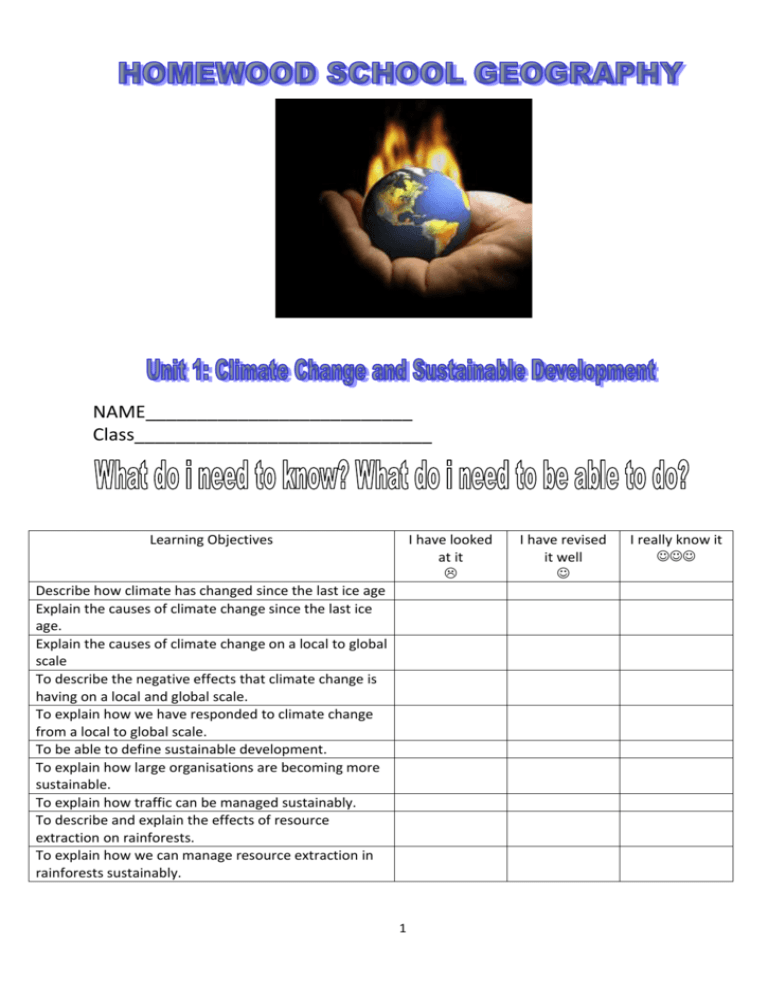
NAME__________________________ Class_____________________________ Learning Objectives I have looked at it Describe how climate has changed since the last ice age Explain the causes of climate change since the last ice age. Explain the causes of climate change on a local to global scale To describe the negative effects that climate change is having on a local and global scale. To explain how we have responded to climate change from a local to global scale. To be able to define sustainable development. To explain how large organisations are becoming more sustainable. To explain how traffic can be managed sustainably. To describe and explain the effects of resource extraction on rainforests. To explain how we can manage resource extraction in rainforests sustainably. 1 I have revised it well I really know it Describe how climate has changed since the last ice age From 10,000 years ago, temperatures have risen globally by about 6 degrees Celsius. Within this time there have been some fluctuations. After the last ice age the temperature rose RAPIDLY for 2000 years. Then there were some warmer periods interrupted by a colder period. There have been other warm and colder periods. More recently, temperature has begun to rise rapidly again. Explain the causes of climate change since the last ice age. The causes of climate since the last ice age means changes from 10,000 years ago. People were not the main cause. BIGGER things like the sun, the way the earth orbits the sun and tectonics are the cause. 1) Movement of continents caused by plate movements affects the global pattern of atmospheric and ocean circulation. ORBIT 1) The shape of the Earth’s orbit around the sun changes from circular to elliptical every 95000 years. 2) This causes winds and ocean movements to change which can slowly change the climate. 2) When it is elliptical the world is warmer, when it is more circular the world is cooler. 3) e.g. formation of ice sheet over Antarctica TILT 1) The tilt of the earth’s axis changes over time. When the tilt is bigger, summers are warmer and winters are colder. Overall, warmer periods happen when the tilt is greatest. Solar output: 1) The amount of energy coming from the sun is decreasing. 2) The decrease is small but could lead to lower global temperatures. 3) Sunspots release more solar energy. High global temperatures have been linked to increased sunspot 2 activity in some years e.g.1600s 1)Volcanic eruptions release large amounts of ASH and SULPHUR DIOXIDE into the atmosphere. 2) These act as a cloak and reduce the amount of solar energy reaching the Earth’s surface causing climate to be COLDER. 3) e.g. The Laki volcanic eruption in 1783 in Iceland caused a drop in global temperature. Explain the causes of climate change on a local to global scale Human activity is the main cause of climate change in terms of short term change. Population and wealth has grown causing an increase in greenhouse gases such as methane and carbon dioxide. The Greenhouse Effect This is natural process that keeps the earth warm. Without it, we wouldn’t be able to survive. Humans have ENHANCED the greenhouse effect through the burning of fossil fuels and increased levels of methane. Remember, the greenhouse effect is natural. More greenhouse gases lead to an enhanced greenhouse effect which is not good! Green house gases: Water vapour Methane Carbon Dioxide Nitrous Oxide CFCs The amount of greenhouse gases in the atmosphere have increased because of human activity. Methane Livestock animals produce methane in digestion. They belch and excrete it in their waste. 15-20% of methane in the world comes from livestock. Rice paddy fields release methane. 20% of global methane is released in this way. (The methane is released from microbes in the water 3 breaking down rotting vegetation. About 15% of methane comes from landfill sites, mainly in developing countries. Burning vegetation releases methane. It accounts for about 15% of global methane. Swamps are also a source of methane. CO2 CO2 is released into the atmosphere by the burning of fossil fuels The fossil fuels are: oil, coal and natural gas. e.g. In industry, transport, energy production, deforestation (through burning). Trees Trees are also store CO2. They take it out of the atmosphere in photosynthesis. When the trees are deforested, they cannot take the CO2 out. WHY HAS THE AMOUNT OF METHANE AND CO2 BEING RELEASED INTO THE ATMOSHERE INCREASED? More transport on the road e.g. in USA there are 87 cars per 100 people. = more burning of fossil fuels More rubbish produced = more landfill More paddy fields needed = more methane. (e.g. China) More food is needed More forest cleared for cattle ranching = more CO2 and methane More energy is needed = more burning of fossil fules. More livestock kept = more methane Population has increased KEY POINT: In the exam, make sure you check whether the question is about long term (since the last ice age or 10,000 years ago) or short term (changes on a local to global scale, fossil fules, methane or people) climate change. 4 Describe the changes in temperature since the last ice age. Use data from the graph on page2 in your answer. There has been an increase in the amount of methane being released into the atmosphere. Suggest reasons why. (4) Explain two causes of climate change since the last ice age. (4 marks) Explain how the burning of fossil fuels contributes to current climate change. (4) To describe the negative effects that climate change is having on a local and global scale. There are three main effects you need to know: 1) Sea level rise 2) Falling crop yields (how much we get). 3) Retreating glaciers For each of these you need to know specific examples and the knock on effects. You also need to ensure you have local (UK) and global (the world) examples and the effects on people and the environment. Sea level rise: Falling crop yields: Retreating glaciers Cause: Cause: Cause: - Temperature increase causes the ice sheets to melt and raise sea level. - Changes in rainfall and temperature will affect the type of crops grown and may also reduce the 5 amount grown (crop yield). Glaciers (like rivers of ice) are retreating (getting smaller) because of temperature increase caused by climate change. - The sea water expands in warmer temperatures. . The melting ice could affect ocean currents. The Gulf Stream could be pushed further south making western Europe colder. . LOCAL: There could be more storms and flooding in the UK. E.g. London is protected by the Thames Barrier. However, this could be breached if there is a storm surge. Much of London is on a flood plain and not protected. This could be flooded with storms and sea level rise. Plant and animal species living in high mountains could become extinct (e.g. alpine plants & artic hares). Rising temperatures and lower winter snowfall could cause the Scottish ski industry to disappear. Tropical diseases, such as malaria, could spread to the UK. Britain is likely to experience increased storm activity, possibly leading to a higher flood risk in many region. Low-lying areas near sea level (e.g. the fens) could be flooded unless sea defences are strengthened. A warmer climate may make it more difficult for farmers to grow traditional cereals, such as Oats and Barley. Southern Britain could become drier causing severe water shortages. Global impacts In the Colca region of Peru, people have had to abandon their villages as no snow has fallen in the mountains leading to a lack of water supply. Crop yields in countries such as Tanzania are falling. Polar Bears in Russia cannot catch prey as there has been a loss of sea ice. Bangladesh: If sea level rises by 1m, Bangladesh will lose 17.5% of its land. In Kenya, droughts now happen every 3 years instead of every 10 years. In 2006, Kenya suffered its worst drought in 80 years. Many cattle died (food +money) Low lying areas such as the Maldives will be flooded if sea level rises. 6 The Great Barrier Reef in Australia will be dead within 30 years due to rising sea temperatures. Try to explain knock on effects. E.g. insurance costs rising, loss of income, famine, arguments between countries for resources such as water. Describe the negative effects that climate change is having on people and the environment (6 marks). Explain two LOCAL impacts of climate change. 7 To explain how we have responded to climate change from a local to global scale. What can be done to reduce the threat of Climate Change? Most world leaders now accept that climate change is a threat, and that something needs to be done about it. It seems certain that responsibility for action will lie mainly with HICs as these nations have been, and still are, the major global polluters. There are two different types of response to climate change. 1. Plan now to reduce the damaging effects of warming. Build sea defences to counteract any increase in sea level and storm activity. Improve water catchment and supply in areas likely to become drier, Develop ‘drought-proof’ strains of plants which can grow even in areas of unreliable rainfall. 2. Try to slow down (and possibly reverse) climate change by reducing our greenhouse gas emissions, often referred to as our carbon footprint. Reduce our dependence on fossil fuels. Use renewable forms of energy (wind, solar, tidal etc…). Protect remaining forests and expand carbon sinks through afforestation. Conserve energy in the home and in industry to reduce energy wastage. Plan transport policies to reduce the use of ‘petrol powered’ vehicles. THE GLOBAL RESPONSE 1988: 1992: 1997: The IPCC (international Panel on Climate Change) The United Nations held their first Earth Summit in Rio de Janeiro. Kyoto protocol 2007 Bali/Durban (Bali) and 2011 (Durban) Set to investigate whether our actions were resulting in Climate Change The meeting resulted in the first international environmental treaty which aimed to stabilise greenhouse emissions. lead to legally binding targets carbon reduction targets. Signatories agreed to reduce carbon levels to 5% below 1990 levels. Talks aimed at agreeing new targets to replace the Kyoto Protocols. These talks have also agreed global actions for helping countries affected by climate change, such as providing funding for coastal defences. E.g. Bali Road Map. THE LOCAL RESPONSE A range of local actions have been taken by charities, councils and individuals to encourage us to live more sustainably. These include: The charity ‘Manchester is my planet’ has run a campaign encouraging individuals to make a pledge aimed at reducing their carbon footprint. 8 Manchester council in partnership with NCP car parks introduced the Green Badge Parking Permit. Owners of cars that produce low carbon emissions can apply for the badge that gives them 25% parking discount. Lancashire county council distributed free energy efficient light bulbs and provided grants to homeowners wishing to improve their cavity or attic insulation. HOMEWOOD SCHOOL’s RESPONSE (A local level case study) Solar panels installed on F-block to power T-block/ This aims to reduce the reliance on fossil fuel made energy. Recycling scheme to aid the reduction of deforestation. Installation of energy saving light bulbs. Transport plan has won awards – this means more people use sustainable methods of transport e.g. buses to reduce emissions. Explain one local response to climate change. (2) P E E Using examples, explain how countries work together to tackle climate change. (4) To be able to define sustainable development. In 1980 a UN meeting lead to the publication of the Brundtland report, an important environment document which introduced the world to the concept of sustainable development. It defines it as: “development which meets the needs of the present without compromising the ability of future generations to meet their own needs” 9 Over the past 30 years the concept of sustainable development has been reviewed and revised by many organisations. However the key principal remains the same – Development should aim to improve our quality of life both now and in the future. BP (British Petroleum) considers sustainable to mean responsible whilst Nestle see it as long term – something that can be kept going. Companies like people to think they care but their first priority is profit. To explain how large organisations are becoming more sustainable. Large companies have tried to become more sustainable by a) Actions taken to reduce the company’s carbon footprint through the introduction of renewable energy sources and the use of energy efficient equipment. b) The introduction of new procedures aimed at reducing the amount of waste the company produces, such as re-using and recycling programmes. c) Investment in natural landscapes and habitats through donations schemes. d) The use of education programmes aimed at encouraging their customers and employees to act more sustainably. Google has installed 9,200 solar panels on google campuses in California. It has been able to reduce its dependence on electricity created by fossil fuels by 30%. e.g. Google has made transport more sustainable by providing a free shuttle bus for employees reducing the number of cars on the road. Google has bought a fleet of electric cars which are powered by their solar panels to provide transport around campus. Google gives grants to its employees to buy environmentally friendly cars. Google supports local environmental and community charities. Employees who cycle to work gain points which turn into cash for local charities. 10 Green buildings. Every new store and depot they build is more efficient and produces fewer carbon emissions than when they started their sustainability programme back in 2005. Park ‘n’ recycle. They’ve set up instore recycling facilities in most of their car parks for all those little things the Council might not collect, including carrier bags, batteries and clothing. They have diverted over 94%* of waste from our operations from landfill. They are swapping aeroplanes and lorries for ships and trains where they can. By using trains as opposed to road delivery service, they’ve cut carbon emissions by around 80,000 tonnes since 2001. What’s for afters? They don’t throw any store food waste into landfill. It’s either given to charity, or turned into something useful like energy, biofuel or pet food They are developing innovative product packaging to lighten the load and pack more items into one lorry, transporting it all in one go, reducing the carbon emissions. Explain the policies that one large organisation has developed to make it more sustainable. (4) What is meant by the term ‘sustainable development’? (2) This comes up nearly every year. Learn it! 11 To explain how traffic can be managed sustainably. Explain how transport is being managed in urban areas. (6) 12 What is meant by the term congestion charge? (2) Give reasons why cities like Durham have introduced congestion charging (3) To describe and explain the effects of resource extraction on rainforests. A resource is something we need and use. Extraction is how we get it from nature e.g. mining, cutting down trees (deforestation). MINING in Brazil, Amazon Rainforest for Gold. LOGGING in Cameroon for timber Mercury is used which is toxic. 90% of fish caught in the area (river Tapajos) are contaminated. If eaten it causes cancer and high miscarriage rates. Roads built by logging companies open up the area to illegal loggers and hunters who kill mammels such as elephant, Gorilla and Chimpanzees. They sell the meat to restaurants for lots of money. GAS in Peru. Many roads in the forest have been built causing people to be attracted. They build farms which further destroys the area. MIMING for Gold and Copper in Indonesia Locals are exploited as they are given the lowest paid jobs. OIL Extraction in Ecuador (Oriente region). LOGGING in Cameroon for timber Many plants such as the Periwinkle are now endangered. This also affects people as Periwinkle is used to cure childhood leukaemia. 13 The Baka people work in the saw mills. They are not given protective clothing so can be affected by toxins, parasites and fungus when they breath it in. To explain how we can manage resource extraction in rainforests sustainably. There are a range of management measures that can be used to help protect rainforests from future destruction and damage. Governments taking control of forest regions and then banning resource extraction Governments working in partnership with private organisations Non-Governmental organisations (NGOs) In French Guinana the government has refused to allow a gold mine, after research showed that the mine could adversely affect a rainforest reserve the Malaysian government rejected plans to build a coal power station as the site was too close to an ecological sensitive area. In Madagascar, the government teamed up with Swiss perfume manufacturer, Givaudan. The government gave Givaudan sole rights to an area of pristine forest in a deal where the Swiss firm promised to give a percentage of any profits made from perfumes based on local plants to nearby villages to help finance for public projects, such as new schools and health centres. Nature Conservancy is an NGO which helps local tribes in the Amazon forest develop in a sustainable manner. Nature Conservancy provides training courses that teach resource management and environmental legislation. . Explain the management initiatives used in rainforest areas where resources have been extracted. Use examples in your answer. (4) Outline the effects of resource extraction on tropical rainforest environments and the people who live there. Use examples in your answer. (4) 14



